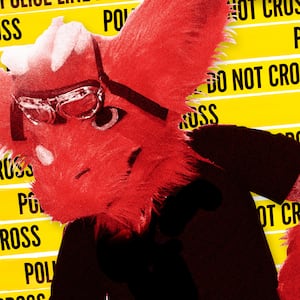It happened every time a school board member spoke up about changes to the Central York School District’s COVID-19 plan. “Meow!” a group of four people would taunt from the back of the room. “Cat!”
Amelia McMillan, a parent in the Pennsylvania district, recognized the four people. They’d supported Central York’s recent (and now overturned) ban on certain school books, many of them about race. After the mid-January meeting ended, McMillan said she saw the group corner a local father in a hallway.
“They were yelling at him about his kid being a furry,” McMillan told The Daily Beast. The group cited “an email someone sent to the board about furries. I heard him say, ‘Leave my kid out of this.’ Two administrators from the school broke up this interaction and shuffled the four aggressors out of the building, and then asked the father if he was alright. He told everyone standing there (myself included) that they were calling his child a furry and he asked them to stop.”
ADVERTISEMENT
Furries are a subculture of people who craft alter-egos as anthropomorphized animals. A furry might draw himself as a cartoon tiger, or dress up as a dragon at a convention for fellow enthusiasts. It’s a decades-old genre and, relative to other available subcultures, fairly wholesome.
So why are school boards attendees in a panic about supposed furries in the classroom?
Want more right-wing news? Subscribe to Fever Dreams on Apple Podcasts, Spotify, Audible, Google Podcasts, Stitcher, Amazon Music or Acast to keep up with the conspiracy-mongers, MAGA acolytes and straight-up grifters. Hosted by Asawin Suebsaeng and Will Sommer.
In Pennsylvania, Maine, Michigan, and Iowa in recent months, school board meetings have been disrupted by allegations that educators are giving special treatment to furry students. While false, the widespread hoaxes play into a broader right-wing effort to discredit and demand further control over public education.
“It’s culture war, it’s control, and it’s not about protecting kids,” Patch O’Furr, proprietor of the furry news site Dogpatch Press, told The Daily Beast. “If you actually look at who’s doing this, at some of the political groups getting involved, they’re all far right.”
The rumors simmered for months in districts like Central York last year, where a “concerned parents” Facebook group promoted fears that furries “could be in your child’s classroom hissing at your child and licking themselves.”
But it was in Michigan’s Midland school district, not Central York, that the claims finally caught fire.
“Yesterday I heard that at least one of our schools in our town, has in one of the unisex bathrooms a litter box for the kids that identify as cats,” a speaker at a school board meeting said, in a video that went viral in January. “And I am really disturbed by that.”
Michigan GOP co-chair Meshawn Maddock soon amplified the cat scat claims. “Kids who identify as ‘furries’ get a litter box in the school bathroom,” Maddock wrote on Facebook. “Parent heroes will TAKE BACK our schools.”
Midland Public Schools do not provide litter boxes—unisex or otherwise. The district’s superintendent debunked the rumor in a scathing email. (“It is unconscionable that this afternoon I am sending this communication,” his email to parents began.)
Nevertheless, the allegations soon spread to Texas, where a GOP candidate (and activist with the right-wing parents group Moms For Liberty) added her own baseless claims about special privileges for furry students. “Cafeteria tables are being lowered in certain @RoundRockISD middle and high schools to allow ‘furries’ to more easily eat without utensils or their hands (ie, like a dog eats from a bowl),” she tweeted.
That allegation wasn’t true, either. In fact, chatter about litter boxes and doggie bowls display a misunderstanding about the furry community, which eats and poops like everyone else, says Sharon Roberts, an associate professor at the University of Waterloo and member of the academic research team Furscience.
“It’s limited fantasy,” Roberts told The Daily Beast of furrydom. “It’s not escapism, it’s not a departure from reality. People who are furries are not like, ‘I am my anthropomorphized character.’ That’s not what happens.”
Furries do not literally believe they are non-human animals, Roberts said. Instead, a furry might play-act the role of a cartoon animal, but when nature calls, she’ll step out of character and remove her costume to use a normal toilet. (Furscience set the bathroom record straight in 2016, when they made a tongue-in-cheek video about the impossibility of using a toilet in a fursuit.)
O’Furr, who has traced the origins of the litter box urban legend, dates the hoax to at least 2008. That’s when a local news story about a Pittsburgh furry convention led to unfounded speculation that hotel staff would have to clean up convention-goers’ poop.
Those rumors appear to have resurfaced with the start of the 2021-2022 school year. In August, for instance, an anonymous grandparent told Kentucky’s WLKY that her grandchildren were being bullied in class by students who made hissing noises. The district’s superintendent told the station that “a small number” of students had violated the dress code by wearing cat ears or tails, and that the situation was under control.
But the rumor metastasized in other states, especially when picked up by conservative voices. Blogs in Iowa and Idaho promoted the stories this fall, claiming that furry students were either being granted special litter boxes, or were being exempted from homework (can’t grip pencil with paws). The blogs noted that schools had denied the allegations, but the authors went on to say they’d heard more rumors from locals and people “at the Clay County GOP booth at the county fair.”
Such rumors, if true, threatened to weaken the U.S. military, an Iowa commentator wrote. “As China threatens to invade neighbors, we’re cringing when someone tells us he’s an antelope and we better acknowledge he’s got hooves whether or not visible,” he opined. “How could we possibly win a war with an army filled with dogs and cats?”
Not all of these queries have been warmly received in the furry community. In early November, an aspiring educator took to Reddit’s r/teachers board to relay rumors about students in her hometown demanding litter boxes in school. “I went to r/furry to ask for advice and their opinion on how to handle this situation but got permanently banned,” wrote the Redditor, who is in school to become a teacher.
By October, furry fears were making their way into school board meetings. In Skowhegan, Maine, where Redditors were already sharing litter box rumors, a speaker at a school board meeting “spoke requesting information regarding the district’s stance on allowing students who identify as animals (furry), to be an exception to dress code (hats, etc),” according to the meeting’s publicly available minutes.
A parent raised a similar concern at an Iowa school board meeting that month, and the query took on a more political tone at a board meeting in Minnesota. “Another topic many parents would like addressed are furries,” a speaker said. “Why are kids being allowed to dress up like animals in our schools? They’re being allowed to growl and bark at their teachers. They’re allowed to wear leashes and collars and tails and they just bark but God forbid a kid wears a Trump hat to school; they’re told to take that off immediately.” (Most schools don’t allow hats.)
The politicization of furry school rumors comes amid a sweeping conservative assault on public schools and how they approach issues like race and gender. School board meetings, sometimes attended by members of far-right paramilitary groups, have become theaters for culture wars, with GOP figures like Maddock calling on parents to “TAKE BACK our schools” from the specter of liberal educators.
Sometimes, as in the case of Central York, the same people who supported book bans are the same people now promoting furry rumors.
Furries make a convenient target for people looking to lash out at marginalized identities, particularly the LGBT community, which has a higher-than-average representation among furries, O’Furr noted. Multiple litter box hoaxes make explicit reference to “gender-neutral” litter boxes (a parallel to battles over gender-affirming bathroom choices in schools) or claim that students “identify as furries” (a phrasing uncommon in furry media, but with parallels to how conservative media often describes transgender youth).
“They’re demonizing minorities by proxy, with a target behind the target,” O’Furr wrote in a recent blog post. “It’s a cousin to transphobic memes like ‘I sexually identify as an attack helicopter’ using weirdos to make it easier to swallow.”
The director of the Public Schools Branch in Prince Edward Island, Canada, took a similar stance when furry hoaxes flooded his district’s social media in October.
“It seemed to me like it was a backlash against some of the progressive things that our schools are doing,” director Norbert Carpenter told the CBC, “and we would have many that would say this is rooted in hate and transphobia and homophobia and that message needs to be clear, it’s not acceptable.”
That’s not to say furries aren’t in schools. A recent Rolling Stone article showcased a thriving, TikTok-based furry youth scene. It’s a space for creativity and play, young furries and their parents explained—and like any youth subculture (see: goths and MySpace queens of decades past) some of the allure is in furrydom’s inscrutability to adults.
But efforts to cast anthropomorphized animals as a niche issue are misguided, anyway. Last week, a Tennessee school board banned the Holocaust graphic novel Maus, ostensibly on the grounds that its illustrations of unclothed mice were inappropriate. Meanwhile, conservative commentators accused the left of attempting to “destroy the fabrics of our democracy” for drawing Minnie Mouse in a pantsuit instead of her usual short dress. These dueling debates over mouse attire don’t illustrate some deep American angst over rodent dress codes; anthropomorphized animals, imbued with our own anxieties, have long acted as our proxies in culture wars, regardless of whether we own fursuits.
Roberts, the furry expert, said the furry community can act as a safe home for young people who might be jeopardized by efforts to ban school books about autism and LGBT issues (like Central York schools did earlier this year).
The furry movement is disproportionately LGBT and neurodiverse, “yet we see that furries are thriving in this community,” Roberts said. “It’s because they have a strong bond and connection that’s rooted in creativity.”
But with a fixation on nonexistent litter boxes and lunch tables, the furry panic turns a thriving subculture into a cudgel against public schools and their students. Ironically, O’Furr said, it’s the right—not furries—who won’t stop talking about cat shit.
“It shows a complete failure to understand how kids think, what they care about, what they want,” he said. “They’re targeting the places kids have a little bit of privacy in schools, like their lunch or their bathroom breaks. It’s about control.”








